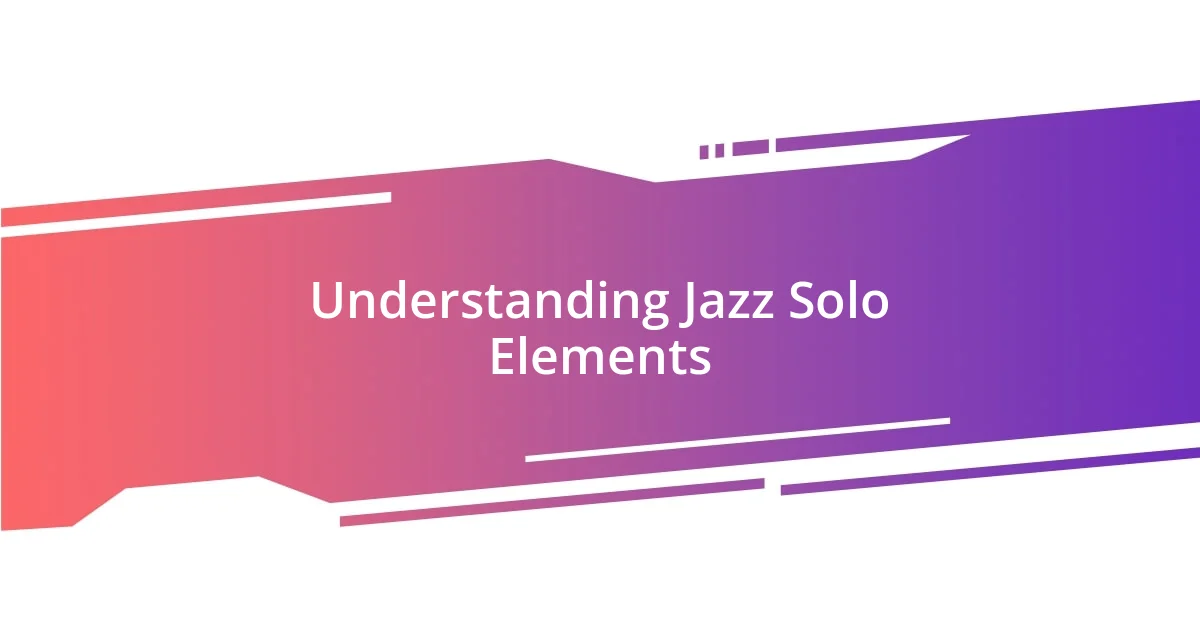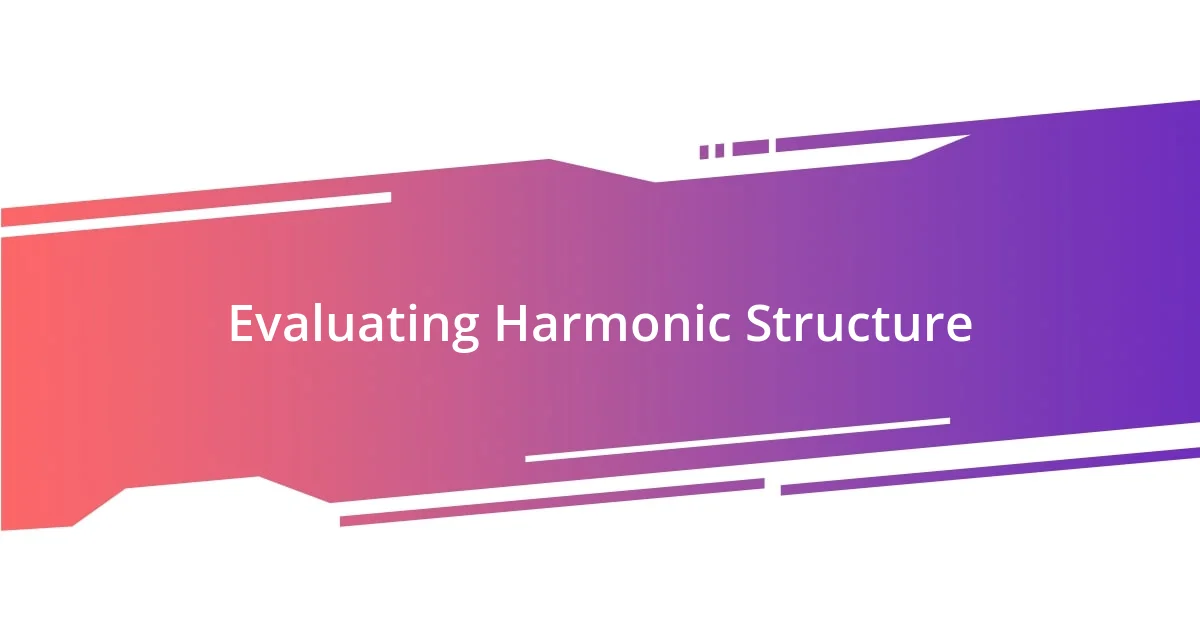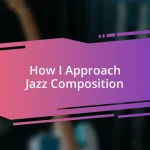Key takeaways:
- Analyzing jazz solos involves key elements such as rhythm, melody, harmony, and improvisational techniques, all of which contribute to emotional expression and narrative.
- Musical phases, including exposition, development, and recapitulation, shape the listener’s emotional connection and highlight the soloist’s storytelling through contrasting dynamics and motifs.
- Practical exercises like transcribing solos and comparing thematic elements can deepen understanding of jazz, emphasizing the collaborative nature and diversity of improvisation among musicians.

Understanding Jazz Solo Elements
When I analyze jazz solos, one of the first elements I focus on is the use of rhythm. The way a musician plays with time can express a spectrum of emotions, pulling the listener in or creating surprising tension. Have you ever noticed how a sudden shift in rhythm can make a solo feel more alive? I remember a moment hearing a saxophonist deliberately drop a beat, leaving a pause that tightened the air in the room, and it completely transformed my perception of the solo.
Next, I pay careful attention to melody, which serves as a personal voice for the performer. Each note sung by an instrument can convey a distinct mood or tell a story. For instance, I once listened to a pianist who weaved a haunting melody through their solo, each note like a brushstroke on a canvas. It made me reflect on how a simple sequence can transport listeners to a different emotional landscape.
Another crucial element is harmony, the foundation upon which the melody thrives. It’s fascinating to explore how chords can create tension or resolution. I often find myself engaged in the dialogue between the solo and the underlying chords. I once caught myself tapping my feet as a guitarist danced between major and minor chords, which instantly altered the mood. Isn’t it amazing how such subtle shifts can evoke a deep emotional response?

Identifying Key Musical Phases
Identifying key musical phases in a jazz solo is both a science and an art. I’ve noticed that solos typically unfold in distinct segments—each with its own character and emotional weight. For example, an opening may set the stage with a clear theme, but as the solo progresses, you can often sense a shift, like a story taking an unexpected turn. I remember listening to a trumpet solo where the artist began with a soft, inviting motif, only to transform it into a fiery crescendo that left the audience breathless.
As the solo develops, these phases often exhibit contrasting dynamics and techniques. From introspective passages to explosive sections, the changes can create a rollercoaster of emotions. I find it intriguing to track how motifs are revisited or reimagined. I recall a memorable performance where a guitarist subtly brought back a previous phrase, but this time it was played with a different intensity, provoking a shared moment of realization among the audience.
These phases not only serve the soloist’s narrative but also engage listeners on a deeper level. While analyzing the structure, I often ask myself which section resonated the most and why. Did it evoke nostalgia, excitement, or perhaps even melancholy? In one unforgettable experience, a drummer drew the audience in with intricate rhythms, building tension that seemed to vibrate in the air—reminding me how powerful these musical phases are in shaping our connection to jazz.
| Musical Phase | Description |
|---|---|
| Exposition | Initial theme presentation, setting the mood. |
| Development | Exploration of themes with varied dynamics. |
| Recapitulation | Return to earlier themes with a fresh perspective. |

Analyzing Melody and Rhythm
When analyzing melody and rhythm in jazz solos, I find it essential to break down how they work together to create a unique expression. Rhythm isn’t just a backdrop; it’s the heartbeat of the music. I recall a mesmerizing bass solo where the player shifted from a steady groove to a playful syncopation. That spontaneous decision seemed to enliven the melody, making it dance around the beat in a way that kept the audience on the edge of their seats.
- Melodic Contour: Analyzing the shape of the melody can reveal emotional highs and lows, just like a journey through a landscape.
- Rhythmic Patterns: Identifying recurring rhythmic motifs can help uncover the soloist’s intent, adding depth to my understanding.
- Interaction Between Elements: Observing how melody twists around the rhythm provides insight into the musician’s unique voice, telling their story in sound.
In my experience, melody often tells a story, and rhythm propels that narrative forward. I remember listening to a jazz quartet where the saxophonist’s melodic phrases echoed the lyrics of an unseen ballad, while the drummer provided a syncopated rhythm that felt like a heartbeat. It created this beautiful push-and-pull where I couldn’t help but feel the urgency and excitement building. That connection between melody and rhythm is a dance that captivates the listener, inviting us to join in the journey.

Evaluating Harmonic Structure
Evaluating harmonic structure in jazz solos offers a fascinating glimpse into how musicians construct their phrases. I remember listening to a stunning piano solo where the harmonic choices seemed almost conversational. Each chord change invited a response, creating a dialogue that felt alive. Have you ever noticed how the right chord progression can evoke a vivid emotional landscape?
When analyzing harmonies, I look for the tension and release that characterize a strong solo. For instance, during a memorable performance, a saxophonist played a series of complex chords that built a palpable sense of anticipation. Just as I thought the resolution was imminent, he opted for an unexpected turn, leaving the audience in suspense. This intentional delay can heighten emotional engagement, making the ultimate resolution even more rewarding.
Moreover, evaluating harmonic structure also involves noticing how a soloist navigates different tonal centers. I recall a live show where a guitarist effortlessly moved between major and minor harmonies, creating an emotional rollercoaster that resonated deeply with fans. It’s fascinating to think about: how do these harmonic shifts affect your personal response to the music? In my experience, every time I hear a deliberate modulation, it feels like a musical invitation to explore uncharted emotional territory.

Exploring Improvisational Techniques
Improvisational techniques in jazz can be incredibly diverse and deeply personal, often reflecting the player’s mood and background. I once attended a jam session where a trumpeter took an unexpected approach by incorporating elements from hip-hop. It was thrilling to hear how he blended rhythmic beats with traditional jazz phrasing, creating a fresh sound that captivated everyone. Have you ever felt how a solo can transport you to a completely different place? That’s the magic of improvisation—it allows musicians to paint a story in real-time.
Another technique that stands out to me is the use of motifs. I often analyze how musicians create a small musical idea and then transform it throughout their solo. I remember listening to a jazz violinist who played a simple four-note phrase and, with each repetition, altered it slightly—changing the rhythm, adding embellishments, or shifting dynamics. It was like watching a sculptor chip away at a block of marble, each iteration revealing more depth and character. Isn’t it fascinating how a simple idea can evolve into something complex and engaging?
One fundamental aspect of improvisation is the dialogue between musicians during a performance. In a recent quartet performance, the pianist and drummer exchanged musical ideas, responding to one another in real-time. This interplay turned the solo into a conversation that felt vibrant and alive. I find that this interaction not only enhances the musical experience but also draws the audience into the moment. Have you experienced that sense of connection in a live performance? It’s that synergy between musicians that makes jazz so captivating and unpredictable.

Listening for Emotional Expression
Listening closely to jazz solos reveals layers of emotional expression that can be profoundly moving. I recall an instance when I heard a tenor saxophonist pour his heart into a slow ballad. Each note seemed to carry a weight of longing, almost like he was sharing a personal story with the audience. Can you remember a moment in music that made you feel like you were eavesdropping on someone’s deepest thoughts?
In my experience, the use of dynamics plays a crucial role in conveying emotion. During a late-night set, I was mesmerized by a bassist who dipped from razor-sharp intensity to hushed whispers, allowing the room to breathe. This ebb and flow created an intimate atmosphere, making every listener feel personally connected to the music. Have you felt how variations in volume can transport you from exhilaration to introspection in a heartbeat?
I also pay attention to the phrasing in a solo, as it offers unique insight into the artist’s emotional landscape. I once listened to a guitarist who expertly used space—pausing at just the right moments to let the silence resonate. It was as if he was giving the audience permission to reflect on the emotion he had just expressed. Isn’t it powerful how sometimes it’s not just the notes played, but the silence between them that evokes the deepest feelings?

Practical Exercises for Solo Analysis
To truly analyze jazz solos, I recommend transcribing your favorite solos. This practice allows you to engage intimately with the music, as you work through each note and phrase. I had a particularly enlightening experience transcribing a solo by John Coltrane; his melodic choices opened my eyes to the intricacies of tension and release within jazz. Have you ever felt like uncovering a hidden treasure when you dissect a solo note by note?
Another effective exercise is to extract thematic elements from different solos and compare them. I once took a week to analyze the repeated themes in solos from both Miles Davis and Herbie Hancock. It was fascinating to see how they each transformed similar motifs into something distinctively personal. Have you explored how diverse approaches can stem from common inspirations?
Lastly, engaging with other musicians during practice sessions can be invaluable. I often invite fellow musicians to analyze solos together, discussing the techniques and emotions behind each note. This collective insight enhances my understanding and exposes me to perspectives I might not have considered. It’s a great reminder of how jazz thrives on collaboration and dialogue—what revelations might come from sharing ideas with your fellow artists?















